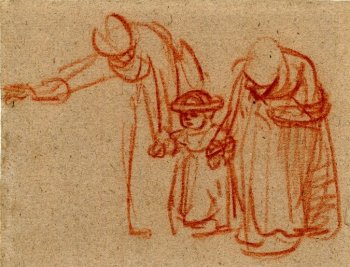
Rembrandt: Two women teaching a child to walk. Red chalk on gray paper, ca. 1635-1637.
Andrew Solomon serves as the Honorary President of the Jury of the 2017 FID Prize, which recognizes outstanding practitioners of drawing.
Serghei Litvin: Andrew, when you look at a drawing, what are you looking at?
Andrew Solomon: I never cease to be amazed at how marks on a surface can represent anything that exists or has existed in the world. I look to drawings to be memories brought to life—someone else’s memories, but in turn my own. I look at the quickness of much drawing and am amazed at how a few lines can evoke sadness or dread, exultation or pleasure, faith or doubt. I see in drawings (more than in much painting) the hand of the artist. It is an intimate art form, and I am honored to be privy to such intimacy.
Serghei Litvin: “Quick intimate marks” do you invite us to take it for your impromptu personal – very personal – definition of drawing? And when you look at a drawing, what are you looking for, first of all?
Andrew Solomon: I am looking for a vision from the artist. It may be a vision of beauty; it may be a moral vision; it may be a vision of psychological nuance; it may be a vision of representation, a grappling with what it means to express yourself on the page. I’m a writer, so I tend to look for the narratives embedded in even the most non-narrative drawings. But I also look for the skill of execution. In other words, I try to understand what a drawing is striving for, and to judge how well it achieves its objectives.
Serghei Litvin: Each of the Top Ten winners will be awarded several texts on her/his work by the jury — and some of them might even have a text signed by Andrew Solomon. If Andrew Solomon agrees. These brief, analytical and critical notes, will be published in the Digital Catalogue, which constitutes the Grand Prize. The notes will place the work of the winners in the broad perspective of the international contemporary art scene. So, you are expecting for vision and skill. But is it something you dislike in contemporary art?
Andrew Solomon: I try not to dislike things; I prefer to like them or move past them. But I have qualms about the way some artists have abused Duchamp’s legacy, frequently to create work that has internal conceptual reference points that are illegible to most viewers. There is a cult of obscurity in some contemporary art that feels snobbish and exclusionary to me. I love wit and I am no aesthetic populist; I think rage can be a powerful force in art; but sometimes what is presented as wit is only an uninspired hostility.
Serghei Litvin: “Quick intimate marks serving a vision — with skill” could that be your definition of drawing?
Andrew Solomon: Drawing is perhaps the oldest form of recorded representation—it came long before written language and well before what we would today see as painting. It is the origin of recording any part of our inner lives. I don’t care to propose a restrictive definition for it. It is what happens when we convey experience, emotion, history, aspiration—any aspect of ourselves through marks.
Serghei Litvin: Thank you, Andrew.
(Foire Internationale du Dessin (FID)
seeks to promote works of art which plot landmarks on the map of the world to come.
For more information, please visit thefid.org.)











